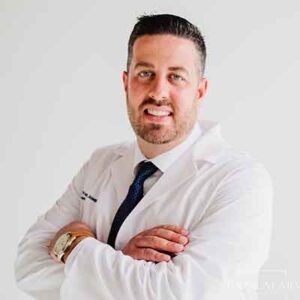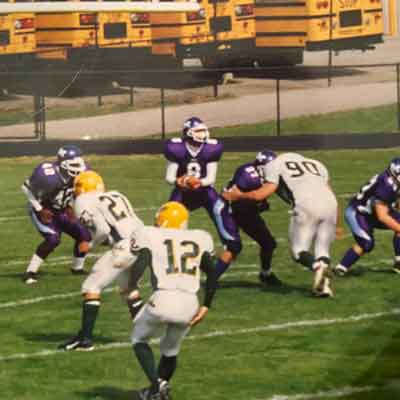New surgical technique quickens recovery time, yields high patient satisfaction
LONDON Trusting his instincts has served Kevin Magone, MD, well in his professional career, from choosing his specialty of orthopedic surgery and sports medicine to his decision to join CHI Saint Joseph Health in London in southeastern Kentucky.
“When we interviewed here four years ago, we had a good feeling from the hospital staff, but we had no idea how much we would enjoy this community. The people here are really nice, not just the hospital staff, but the community as well. Also, I didn’t realize how quickly I would become so busy in my medical practice and covering the local team sports,” says Magone.
A new aspect of his orthopedic and sports medicine practice that Magone instinctively felt would be successful is using the subscapularis sparing surgical technique in his shoulder replacement cases. He states, “I had been trained in the subscapularis sparing technique in my orthopedic fellowship, so I was familiar with it. About eight months ago I decided to start using it with my shoulder replacement patients to achieve better outcomes, quicker recovery time, and more patient satisfaction. So far, my patients are very happy with the results, and I am too.”
Magone explains that there are two types of shoulder replacement surgical procedures: One is the reverse shoulder approach (RTSA) when the normal ball ball-and-socket relationship is reversed and the ball is placed in the socket, not at the top of the humeral bone. The other option is the anatomic shoulder replacement, known as total shoulder arthroplasty (TSA). In the traditional anatomic technique, the rotator cuff is taken down, he says, to insert the new shoulder joint. Taking down the rotator cuff musculature requires the patient to wear a sling for six to eight weeks to support the arm while the rotator cuff heals.

“Patients don’t like having to keep their arm in a sling for six weeks after surgery,” says Magone.
In the subscapularis sparing technique, Magone says he doesn’t take down the rotator cuff while inserting the new shoulder joint. The caveat to not taking down the rotator cuff during this procedure is that there are not any prior tears in the rotator cuff. “I tell my patients before surgery that I won’t know for certain if the rotator cuff is intact until I see it. We have looked at it in advance by MRI, but until I can see it with my own eyes, I can’t be certain. So far, I haven’t had to change course after about 18 surgeries in eight months, but there’s always that possibility. My patients understand that and are happy with the process,” says Magone.
Benefits of Sparing the Subscapularis
Patients derive multiple benefits from the subscapularis sparing technique. The most obvious is shorter recovery time when the arm can be released from a sling in about one week rather than eight weeks, after the swelling subsides and the small incision wound heals.
Pain management associated with post-operation recovery is about the same, or less, says Magone. He theorizes that patients do better with the pain when they are not using the sling and have better range of motion and normalized activity. “It’s subjective, and long-term data is still being collected, but my short-term results tell me that patients are much happier being out of the sling quicker because of not taking down the rotator cuff,” he says.
“I really want patients who need shoulder replacement surgery to know that this procedure, and the subscapularis sparing approach, is now available to them in London, Kentucky. They don’t have to drive to Lexington or Knoxville to have it done. I’m seeing patients with outcomes in six weeks that otherwise would take six to eight months,” says Magone.
A Doctor’s Role in the Community
Not only is Magone bringing new surgical techniques to London, he and his family are quickly putting down roots and becoming totally immersed in the southeastern Kentucky community. Magone, a multi-sport high school athlete, is now the team doctor for Whitley County and both North and South Laurel County high schools and middle schools. He says he covers all the sports including football, basketball, soccer, baseball, and even golf. He says his goal is to support the school athletic trainers and be a resource when needed. “The athletic trainers do a great job here; they are very well trained in their specialty,” he says.
Magone and wife Ashley now have three children of their own, and all of them are involved in some type of sports activity. “My older two boys Mason and Maverick are nine and seven. They play football, basketball, baseball, and golf and are on a swim team. My youngest, our daughter Mila, takes dance, does gymnastics, and starts softball soon. We stay very busy,” he says.

Magone’s decision to become an orthopedic surgeon was a natural for him because his father, Jerry, is a retired orthopedic surgeon who practiced at Middletown Regional Hospital, just north of Cincinnati. Magone was further drawn to the profession because he likes to work with his hands and he had some experience in orthopedics as a high school athlete. He suffered an ACL injury and broke his hand in football, which required surgery, and in basketball he re-tore his ACL. Magone received his undergraduate degree from the Ohio State University and his medical degree from the Wright State University Boonshoft School of Medicine. He did his residency at Michigan State University McLaren-Flint Regional Medical Center before taking a fellowship in shoulder and elbow surgery at the NYU Langone Orthopedic Hospital in New York.
The Non-Surgery Surgeon
It is a common misconception among patients, but not all shoulder or elbow problems need surgery, says Magone. “Just because I’m an orthopedic surgeon, that doesn’t mean I have to operate on every patient. We always use a conservative approach first. Most of my patients are here for chronic, arthritic pain relief and restored function and increased range of motion.”
The follow-up patient visits motivate Magone. “When a patient comes in three to six months after surgery or treatment, they just want to tell me about all the things they can do now that they couldn’t do before. That’s the best thing to hear; it really makes me happy and want to continue each day,” says Magone.
That’s a good feeling to have.




